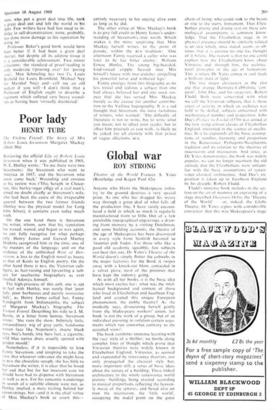Poor lady
HENRY TUBE
The Violent Friend: The Story of Mrs Robert Louis Stevenson Margaret Mackay (Dent 50s) Reviewing the official Life of Robert Louis Stevenson when it was published in 1901, W. E. Henley wrote: 'To me there were two Stevensons: the Stevenson who went to America in 1887; and the Stevenson who never came back.' Wounding and envious as his review was (`This Seraph in Choco- late, this barley-sugar effigy of a real man'), aimed no doubt chiefly at Stevenson's wife, who had been the cause of the irreparable quarrel between the two former friends (Henley was the physical model for Long John Silver), it contains even today much truth.
On the one hand there is Stevenson the writer, whom, now that his reputation has waxed, waned, and begun to wax again, we can fully recognise for what perhaps only Henry James and Gerard Manley Hopkins recognised him at the time, one of the masters of the language; and on the evidence of the unfinished Weir of Her- miston, a loss to the English novel as heavy as that of Keats to English poetry. On the other hand there is RLS, the Victorian cult- figure, as hair-raising and lip-curling a sub- ject for saccharine biographers as ever rivalled Adonais himself.
The high-priestess of this cult, one is apt to feel with Henley, was surely that `poor lady, poor barbarous and merely instinctive lady', as Henry James called her, Fanny Vandegrift from Indianapolis, the subject of Margaret Mackay's biography The Violent Friend. Describing his wife to J. M. Barrie, in a letter from Samoa, Stevenson wrote: 'She runs the show. Infinitely little, extraordinary wig of grey curls, handsome waxen face like Napoleon's, insane black eyes, boy's hands, tiny bare feet, a cigarette, wild blue native dress usually spotted with garden mould.'
Nonetheless, if it is impossible to love Fanny Stevenson, and tempting to take the view that whatever relevance she might have to RLS the chocolate seraph, she has little to Stevenson the writer, it is clear that he loved her and that but for her incessant care we should have had to dispense with Stevenson as well as RLS. For his romantic wanderings in search of a suitable climate were not, as Henley implied, a mere trailing behind her apron-strings, but—and it is the chief virtue of Miss Mackay's book to assert this—
entirely necessary to his staying alive even as long as he did.
The other virtue of Miss Mackay's hook is to give full credit to Henry James's under- standing of Stevenson's true worth. Which makes it the more surprising that Miss Mackay herself writes, to the point of parody, within the RLS tradition: 'One afternoon Fanny received a caller who was later to be her bitter enemy: William Ernest Henley. The young big-bearded, loud-voiced cripple heaved into Mrs Sitwell's house with two crutches propelling his powerful torso and withered legs.'
Fanny emerges from this biography as no less trivial and tedious a subject than one had always believed her and one must sus- pect that she has served Miss Mackay merely as the excuse for another contribu- tion to the Vailima hagiography. It is a sad thought that Stevenson, the most fastidious of writers, who warned: 'The difficulty of literature is not to write, but to write what you mean; not to affect your reader, but to affect him precisely as you wish', is likely to be yoked for all eternity with that prince of vague affections, RLS.


































 Previous page
Previous page